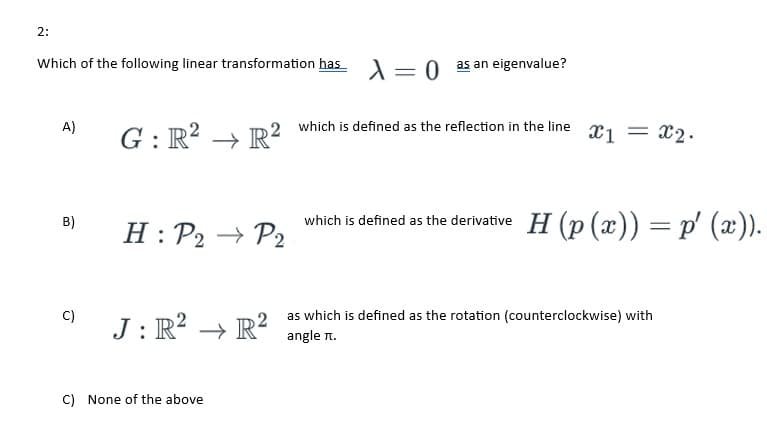Which of the following linear transformation has A) B) C) G: R² → R² H: P2 → P2 J: R² → R² 2 which is defined as the reflection in the line C) None of the above λ = 0 as an eigenvalue? which is defined as the derivative X1 = x2. H (p (x)) = p' (x)). as which is defined as the rotation (counterclockwise) with angle π.
Which of the following linear transformation has A) B) C) G: R² → R² H: P2 → P2 J: R² → R² 2 which is defined as the reflection in the line C) None of the above λ = 0 as an eigenvalue? which is defined as the derivative X1 = x2. H (p (x)) = p' (x)). as which is defined as the rotation (counterclockwise) with angle π.
Elementary Linear Algebra (MindTap Course List)
8th Edition
ISBN:9781305658004
Author:Ron Larson
Publisher:Ron Larson
Chapter7: Eigenvalues And Eigenvectors
Section7.CR: Review Exercises
Problem 16CR
Related questions
Question
kindly answer it perfectly more than one correct options are possible

Transcribed Image Text:2:
Which of the following linear transformation has X = 0 as an eigenvalue?
A)
B)
C)
G: R² → R²
H: P2 → P2
J: R² → R²
C) None of the above
which is defined as the reflection in the line x1 = x₂.
which is defined as the derivative H (p(x)) = p′ (x)).
as which is defined as the rotation (counterclockwise) with
angle π.
Expert Solution
This question has been solved!
Explore an expertly crafted, step-by-step solution for a thorough understanding of key concepts.
Step by step
Solved in 4 steps with 3 images

Recommended textbooks for you

Elementary Linear Algebra (MindTap Course List)
Algebra
ISBN:
9781305658004
Author:
Ron Larson
Publisher:
Cengage Learning

Linear Algebra: A Modern Introduction
Algebra
ISBN:
9781285463247
Author:
David Poole
Publisher:
Cengage Learning

Elementary Linear Algebra (MindTap Course List)
Algebra
ISBN:
9781305658004
Author:
Ron Larson
Publisher:
Cengage Learning

Linear Algebra: A Modern Introduction
Algebra
ISBN:
9781285463247
Author:
David Poole
Publisher:
Cengage Learning